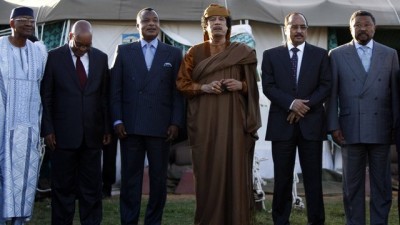Muammar Gaddafi has accepted a roadmap for ending the conflict in Libya, South African President Jacob Zuma said after leading a delegation of African leaders at talks in Tripoli.

‘I have some commitment which is compelling me to leave now but we have completed our mission with the brother leader (Gaddafi),’ Mr Zuma said after several hours of talks with the Libyan leader at his Bab al-Aziziyah compound.
‘The brother leader delegation has accepted the roadmap as presented by us. We have to give ceasefire a chance,’ he said, adding that the African delegation would now travel to the eastern city of Benghazi for talks with anti-Gaddafi rebels.
Libyan rebels beat off a new assault by Gaddafi’s forces on the besieged western city of Misrata, losing as many as 30 fighters but helped by more intense NATO air strikes.
As fighting raged on for the coastal town, where conditions are said to be desperate, a buoyant Muammar Gaddafi made his first television appearance for five days and his troops engaged rebels in more fighting on the eastern front of the civil war.
Misrata is the last major rebel outpost in the west of Libya. Gaddafi’s forces appear bent on seizing the city and crucially its port, which some analysts say Gaddafi needs if he is to survive a long conflict.
A rebel spokesman said that fighting centred on a road to Misrata port, where a Red Cross vessel brought in badly needed medical supplies earlier in the day.
The spokesman praised what he called a positive change from NATO, saying its aircraft carried out several air strikes on Gaddafi’s besieging forces.
Rebels have complained for days that NATO is too slow to respond to government attacks.
A government-organised trip to Misrata revealed deserted streets and many heavily shelled buildings in the city’s south.
An official there said a NATO strike hit the outskirts and a warplane could be seen sweeping across the sky.
NATO aircraft hit 15 tanks near Misrata and two south of Brega in the east of the country on Friday and early yesterday, an alliance official said.
NATO’s commander of Libyan operations said the alliance, which took command of air strikes against Gaddafi on 31 March, had destroyed ‘a significant percentage’ of his armoured forces and ammunition stockpiles east of Tripoli in the past 24 hours.
Canadian Lieutenant General Charles Bouchard also accused Gaddafi’s forces of using civilians as human shields.
‘We have observed horrific examples of regime forces deliberately placing their weapons systems close to civilians, their homes and even their places of worship,’ he said in a statement.
In Tripoli, Gaddafi, who was last seen on television on 4 April, was shown smiling and pumping his fists in the air at a school where he was welcomed ecstatically.
Wearing his trademark brown robes and dark glasses, Gaddafi looked confident and relaxed, confirming the impression among analysts that his administration has emerged from a period of paralysis and is hunkering down for a long campaign.
Gaddafi’s military have pushed back a rebel advance in the east, and inconclusive battles have been fought along the desert road between the Mediterranean oil port of Brega and Ajdabiyah, gateway to the rebel stronghold of Benghazi, for over a week.
Rebels had said they had intended to take Brega and some had penetrated the outskirts. But their assault seemed to have petered out by nightfall, following a familiar pattern. RTE
Leave a Reply
You must be logged in to post a comment.